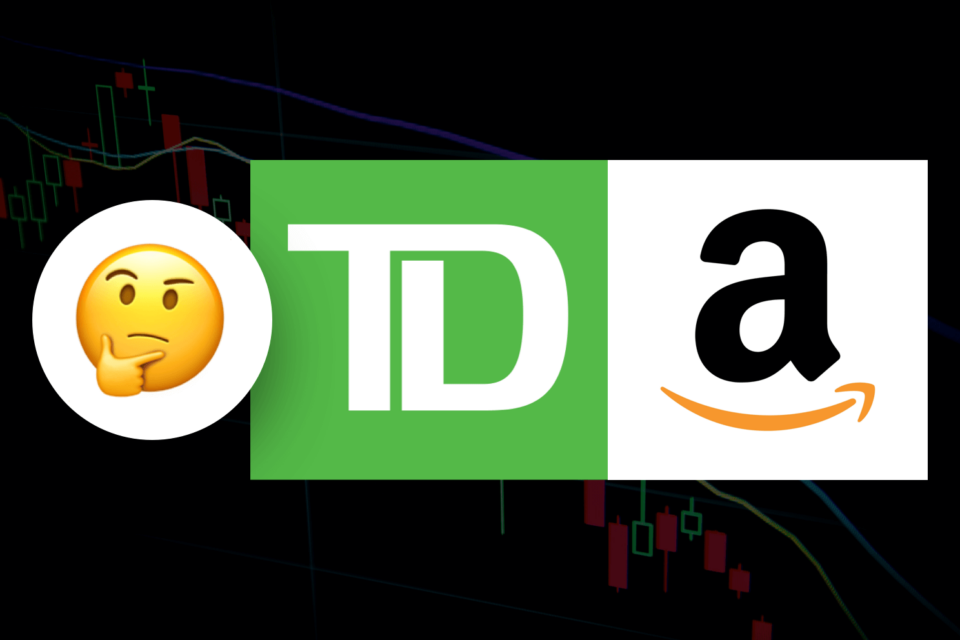TD and Amazon: Buy on Weakness?

TD and Amazon: Buy on Weakness?
This week we look at two titans, one on Bay Street (with a growing footprint to the south) and another in Silicon Valley. Both are touching recent lows. TD and Amazon: buys or passes?

The banking crisis may finally be over (fingers crossed) with First Citizens Bank buying failed competitor, Silicon Valley, on Monday. The street believes so with financials leading Monday’s modest rally. Between March 1-23, TD shares slid 13.8% compared to BMO losing 9.8% and Royal only 4.1%. TD was especially punished because of its large U.S. presence and for planning to buy U.S. bank, First Horizon for $13.4 billion. Because of the bank meltdown, the street now values that deal at only $8 billion.
The italics in that sentence are key, because TD can either renegotiate the price or walk away from the deal altogether. Note that First Horizon’s depositor base shrank 10% over the past two quarters, pre-dating the SVB collapse, so some TD shareholders would like to see the deal nixed anyway. At the very least, TD paying far less for First Horizon remains palatable and slightly accretive to TD over time.
The deal deadline was already extended from February to late-May, because both parties had not obtained all the regulatory approvals. This is another lucky break for TD who remain “fully committed” to closing the deal. If TD goes ahead, TD would become America’s sixth-largest bank, with a presence across 22 states.
Canadian investors are well-familiar with TD. It ranks second behind Royal in size, pays a 4.97% dividend, trades at a beta of only 0.83 and 9.47x earnings, and boasts a 37.52% profit margin. Also, TD beat its last four quarters. As recently as February, TD was trading at $93.56 and only on Monday has it started climbing above $78 after its recent punishment. It currently trades below its 50- and 200-day moving averages of $88.16 and $86.93 respectively by around $10.
TD stock is clearly oversold, more than the other Canadian banks. I don’t need to tell readers that Canadian banks enjoy an oligopoly, and they pay robust and sustainable dividends. TD and its sector should recover into April, though keep an eye out for any First Horizon news. A lower price or an outright cancellation will boost TD shares.

Why is that the number-one player in e-commerce and cloud computing has gone nowhere in the past three years? On March 23, 2020 when the world slid into lockdown, Amazon shares fell to $95.14.
On March 23 this year, shares closed at $98.71. Amazon has round-tripped, and because Amazon doesn’t pay a dividend, shareholders who clung to that ride have earned less than 4%. That doesn’t keep pace with inflation which is the highest in 40 years. Consider that over the last three years, Meta has climbed 30%, Microsoft 86%, Alphabet 88%, Apple 158% and Tesla 465%.
I’ve been watching Amazon for a long time. Every quarter, analysts either buy now and wait for better things to come, or sit on the sidelines. I remain the latter camp, considering Amazon a perpetual show-me story. Don’t get me wrong. I use Amazon as a consumer. So do my neighbours and friends, judging by all the Amazon boxes being delivered.
Amazon deserves attention because megatech has rebounded this year after suffering a horrible 2022. Apple, for instance, has rallied 23% since the year started while Tesla has leapt 69%. Amazon has climbed 17%, which is as much as the QQQ tech ETF, but still lags its peers. Why?
Amazon’s total net sales in Q4 2022 was $149.2 billion. Amazon remains the king of e-commerce with 38% U.S. market share (Walmart only 6%). Indeed, online stores accounted for $64.53 billion of total Q4 2022 sales, but revenues were down 2.34% year-over-year. Meanwhile, AWS accrued $21.38 billion in sales, but revenues shot up 20.24%. Moreover, AWS boasts a 29% operating margin. Since 2020, cloud computing has made up $54.9 billion of Amazon’s operating profit or over 90%. That means, every other segment comprises that remaining 10%.
In that quarter, AWS held the top spot at 32% market share in cloud computing. The good news is that AWS has held steady around 31-33% since late 2017. The bad news is that AWS has held steady around 31-33% since 2017. In that time frame, number-two Microsoft has jumped from 13.7% market share to 23% while third-ranking Google has gained from 7.6% to 10%.
While AWS has been standing still, its competition has been gaining. Bulls point out that the overall cloud business will expand 14% compounded annually through 2027, so AWS has a runway of growth. Well, so do Google and especially Microsoft who could even capture more of that future growth.
True, digital ads and third-party sellers have also grown, around 20% YOY as of Q4-2022, while Prime memberships have climbed 13% in net sales. However, they don’t boast the margins of AWS.
Then, there are the wider headwinds: a recession will impact both e-commerce sales and digital ads. Not sure how cloud computing will be effected, since the growing embrace of cloud by business may or may not offset slower enterprise sales. Though it isn’t new, governments around the world will continue to challenge Amazon with antitrust lawsuits.
For instance, California alleges that Amazon is punishing smaller e-retailers, while booksellers have long complained that Amazon is bullying them with of its sheer market dominance. Meanwhile, workers—who have justifiably been complaining of overwork and hazardous conditions—are gradually unionizing.
Yes, this $1 trillion company remains innovative and invests in the future, but it also trades at a 136.72x PE and shares have gone nowhere in the last three years. There are better tech stocks out there.



